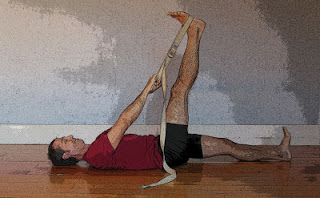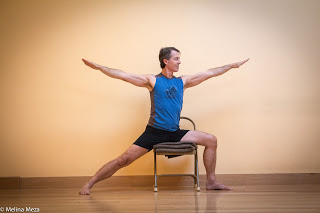
Q:
Do you have any posts on yoga and hallux limitus, especially for those
also with back issues (osteoporosis, DDD, osteoarthritis)? I use yoga as
a main form of exercise and to aid in pain relief from these issues but
am now faced with limited yoga poses as a result of limiting pressure
on the big toes. Any advice would be welcome!
A:
In the past, I have written posts about conditions of the feet and toes
that can lead to pain and dysfunction (see links below), but I have not
specifically addressed the condition of the big toe known as hallux
limitus. In the name of this condition “hallux” refers to your big toe
and “limitus” (related to “limited”) means stiffness. In this case it is
the joint between your long first metatarsal bone and the first phalanx
bone of the big toe itself that is affected. As this condition develops
over time, the stiffness and limited ability of the joint to extend
(bend up away from the floor) can progress to pain, especially when
walking and doing other weight bearing activities on the feet. The
condition is often associated with people who have flat feet and an
elevated first metatarsal bone, and also can develop after an acute
trauma to the foot or recurring trauma, such as “turf toe,” which some
athletes get after kicking the turf and jamming the big toe over and
over again. The presence of stiffness may indicate some arthritic change
to that toe joint, so if you suddenly develop persistent stiffness in
your big toe it may be worth getting an X-ray.
Hallux
limitus is sometimes also present in those with bunions, a condition
known as hallux valgus, where the toe bones of the big toe shift toward
the little toe side of the foot and swelling occurs in the inner edge of
the joint. The bottom line is that as the big toe gets stiffer, and
usually more arthritic (which an X-ray will indicate), it can affect
your ability to walk pain-free with a normal gait, something you
certainly would like to preserve if you can.
There
are four progressive stages to hallux limitus, and in the early stages,
stretching the big toe is one of the recommended treatments (along with
RICE—see Acute Orthopedic Injuries—
and the use of orthotics). It is at this stage where I believe yoga can
be of greatest help. Here are a few suggested options for you to
consider:
For
an acute phase, where there is stiffness and pain (and maybe some
swelling), I’d recommend doing non-weight bearing poses, especially
where the feet can be up in the air, such as Reclined Leg Stretch pose, version 1 with the leg straight up.

In these
positions, try gently flexing and extending all the toes, with specific
focus on the big toe, to maintain as much range of motion at the joint
as possible. As pain improves, supported standing poses, such as Warrior
2 or Lunge poses with a chair, will to assess your ability safely bear
weight if you can do them without pain.


In
non-acute phases, where stiffness alone or with only occasional brief
pain is present, you can begin to work more actively in your standing
poses. To strengthen the myofascial support along the inner arch towards
the big toe, try doing the standing poses while lifting all the toes as
far up off the ground as possible while the ball of the foot remains
grounded. If you can’t lift your big toe on your own, try slipping a
yoga wedge or a folded mat just under the big toe to encourage some extension. Start with short holds of 15-30 seconds and gradually work
toward holds.

Another
way to mobilize your big toes is to use a strap or elastic band under
your big toes in a standing pose, such as Standing Forward Bend or
Pyramid pose, where you have easy access to your big toe or toes. Once
you are in the pose with the strap in place, slowly but actively lift up
your big toe/toes into extension with the strap while keeping the ball
of your foot/feet grounded. If osteoporosis and back pain are a concern,
you can try this in a modified Standing Forward Bend, coming only part
of the way down and not rounding your spine.

In poses
where your back toes are turned under, such as Lunge pose, which
requires more maximal big toe extension, you could try putting a wedge
under the toes of your back foot to decrease the angle of bend a bit and
gradually work your way back to have the toes on the floor.

And
definitely try out other creative ideas that you come up with on your
own to help maintain as much pain-free mobility as you can. At this time
there are no specific studies on the use of yoga for hallux limitus,
but for all you yoga researchers and yoga therapists out there, this is
new territory just waiting for you to look into it further!
Here are my previous posts on feet and big toes:
New Tricks for Old Dogs: Working with Bunions
Friday Q&A: Bunions, A Can, and A Rubberband
(I will
not be addressing the other back and bone conditions that the reader has
mentioned, but we have also written about many of them on the blog,
too.)
— Baxter
Follow Yoga for Healthy Aging on Facebook ° To order Yoga for Healthy Aging: A Guide to Lifelong Well-Being, go to Amazon, Shambhala, Indie Bound or your local bookstore.


I teach a pose called "screaming toes" (not sure if it has another name). The yogi sits as in hero's pose but directly on the heels bending all the toes. This stretches all the toe joints, the mid-foot (plantar fascia) and helps for hikers who get toe pain in rough terrain.
It's great prevention, but no one with hallux rigidus or hallux limitus is going to be able to even do it, unless you want to truly hear some screaming…
I have recently been diagnosed with hallux limitus. My podiatrist has advised that I do yoga with my shoes on (not my idea of comfortable yoga) to support and prevent bending the toe. My condition is not advanced, and I have some flexion range of my toe, but the goal is to restrict movement because the cartilage has worn and there is bone on bone friction that causes pain. This condition is often caused by a malformation of the bone that creates joint movement dysfunction, stretching the toe will not make improvement. It's more of a structural defect or overuse condition, either way, there is loss of cartiledge protection and as such, by definition, a type of arthritis. I am just starting to experiment with doing yoga with the condition but with the goal of modifying poses to accommodate the toe rather than expecting to correct the toe.
I have the same issue. I ordered an insert and then put the insert into some snug slippers. That way you can do your poses and still support the toe.
I notice that those standing poses, that align the different body parts do not strain the foot and related joints as much as some others poses do. So rather do an utkatasana than a trikonasana or parivrtta trikonasana. Utkatasana stays within the range of the frame of your body.
But also a non weight bearing asana like parsvaika pada sirsana influences the bones in the foot because of the wide extension in the hips. Better sirsana simple than parsvaika pada sirsana. At least according to my Hallux limitus/rigidus.
So yes I slowly integrate other types of practices like Feldenkrais. It softens the muscles and posture. It is a good starter.
The soft hip movements from Feldenkrais relax the bones in my foot. Then I am ready to do asana.
After that I do yoga that aligns in the most possible way. Like for instance utkatasana. An only then I can say I feel free to experiment further.
I believe it's my yoga. Not the yoga system as a whole that helps me personally.
But honestly. I do not know what I will learn, loose or gain in a couple of years from now.